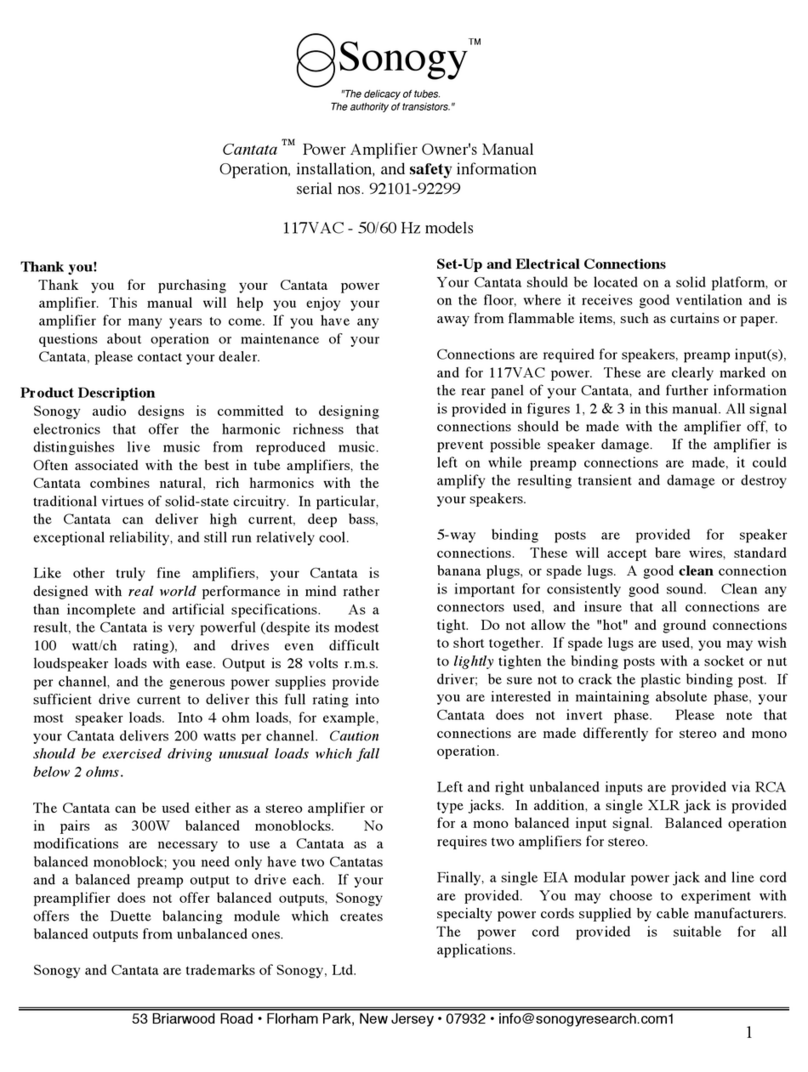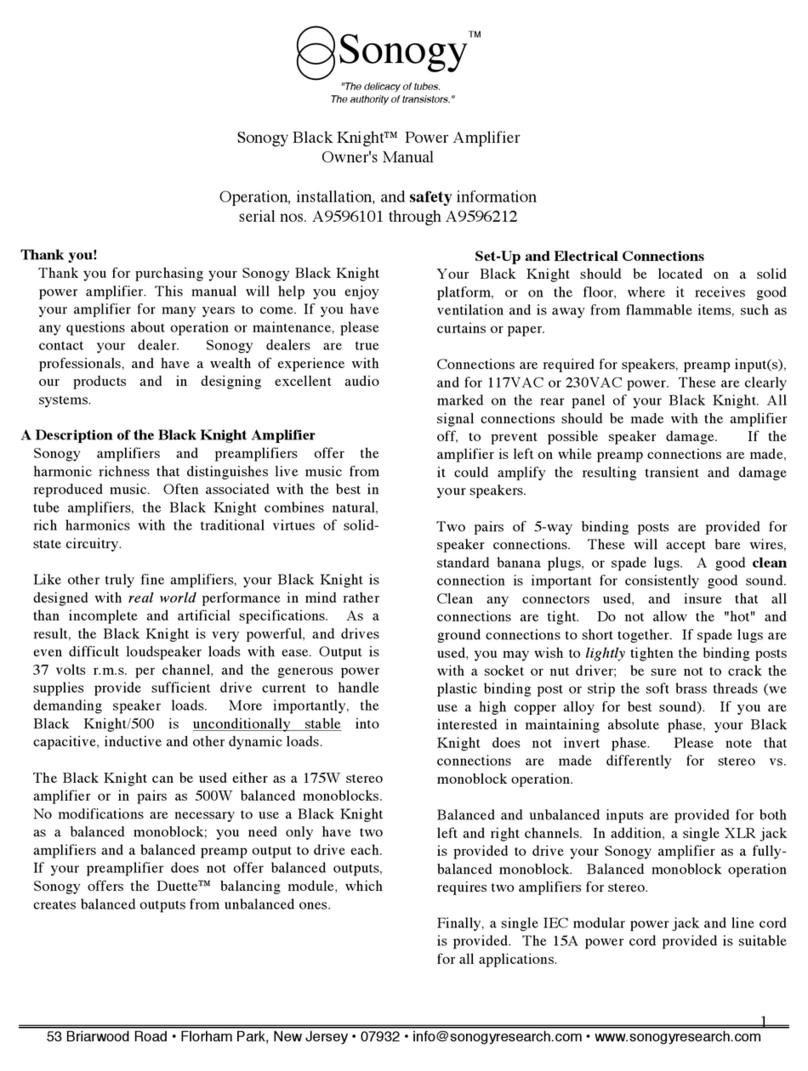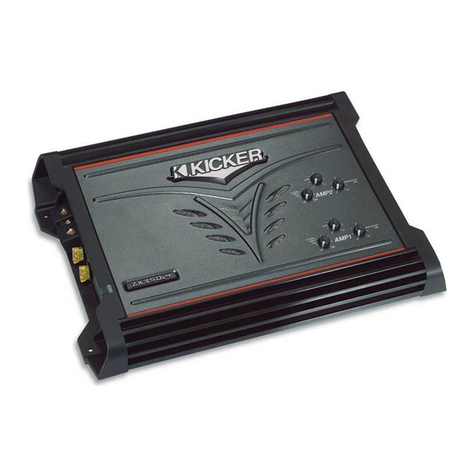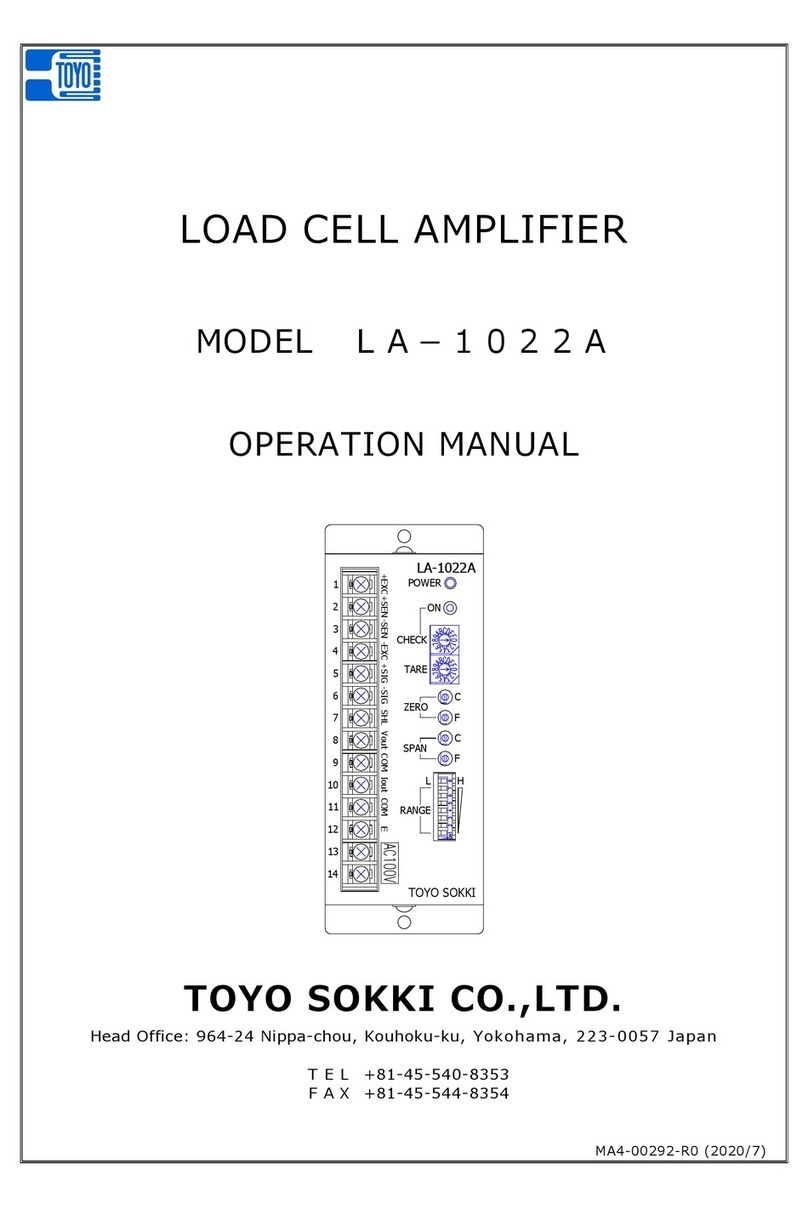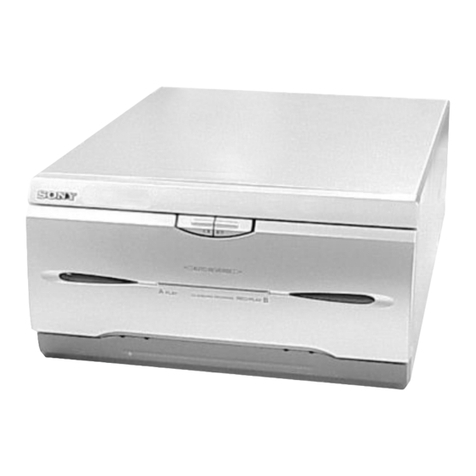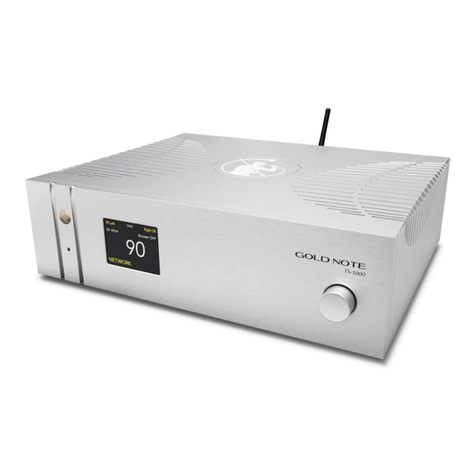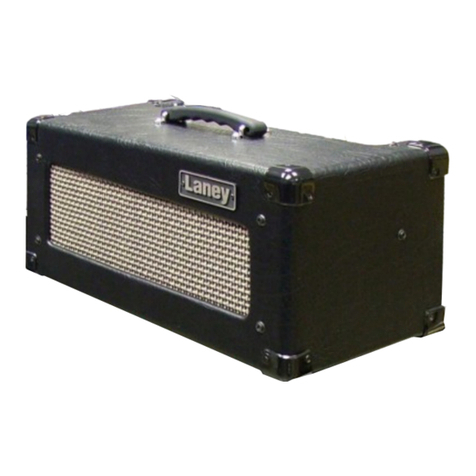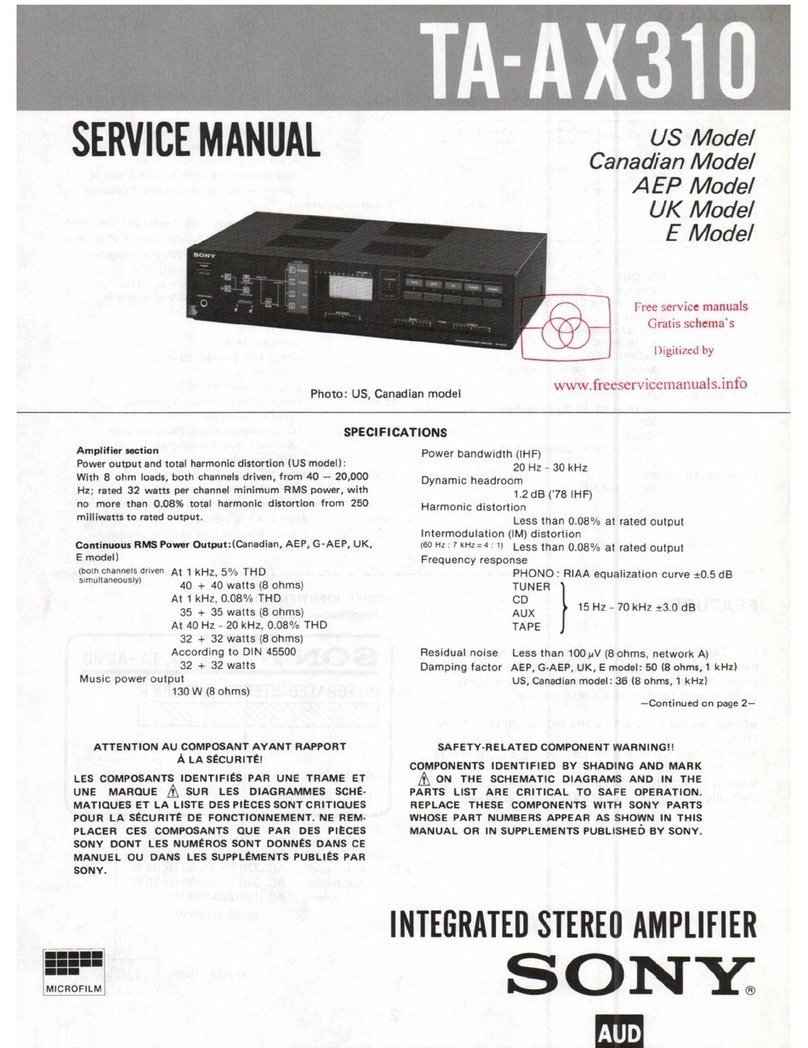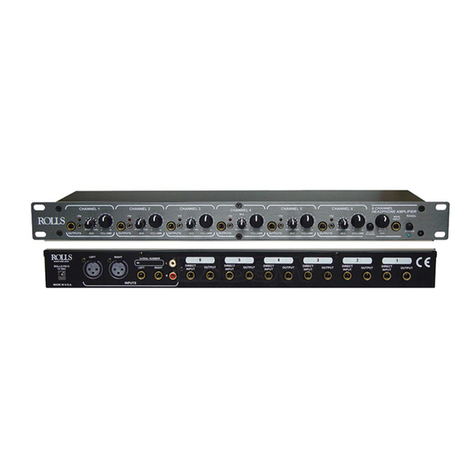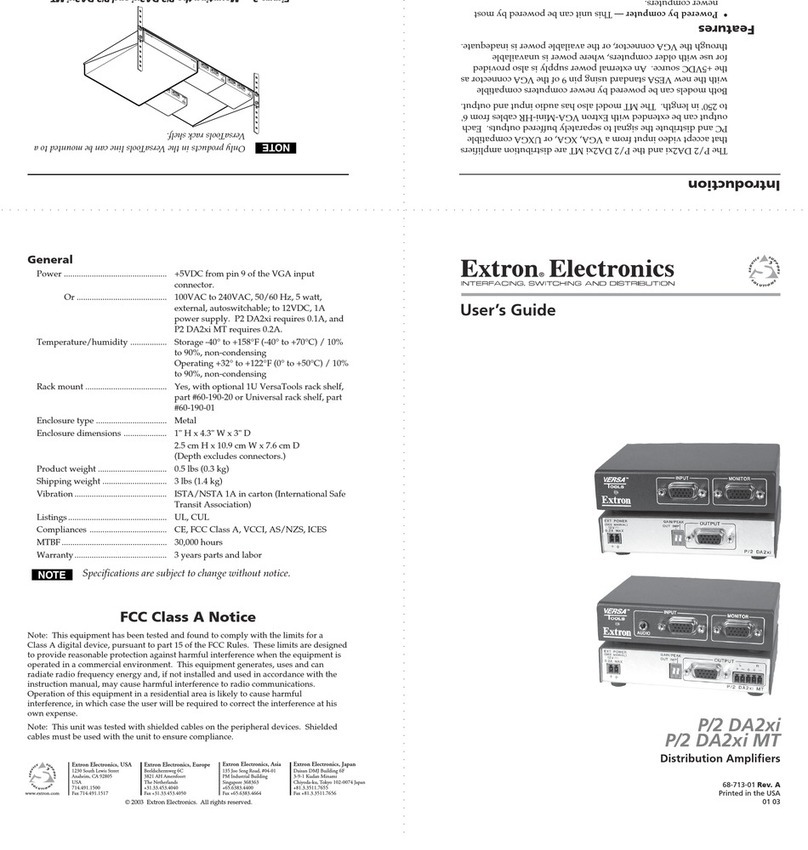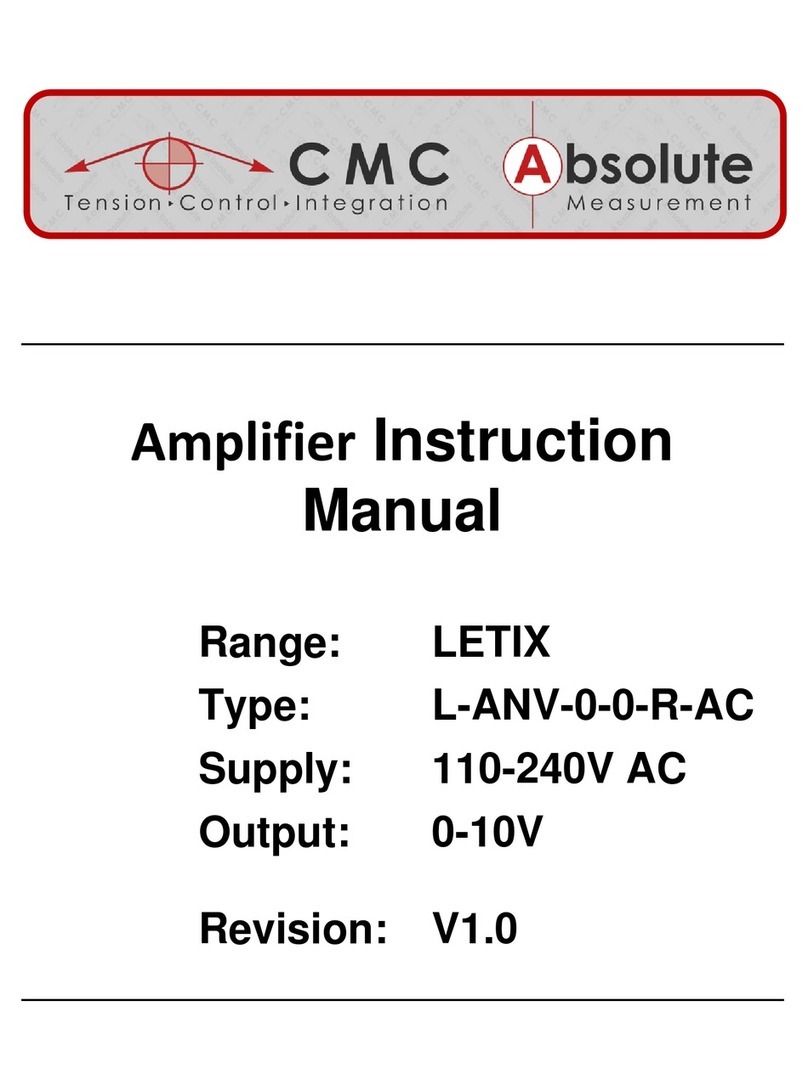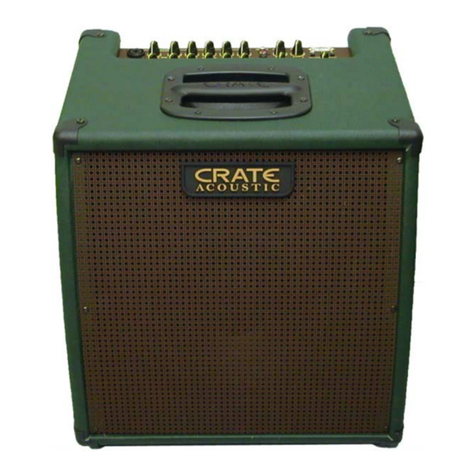Sonogy Concerto User manual

Sonogy
TM
"The delicacy of tubes.
The authority of transistors."
Concerto™Modular Preamplifier
Owner's Manual
Introduction:
Thank you for purchasing Sonogy's Concerto™ preamplifier system. It represents some of the most
unique and advanced thinking on how to combines unrivalled sound quality with practicality and ease of
use. If you take the time to read this manual, we believe that you will enjoy your Concerto all the more.
Don't Blow Up Speakers!!!
CARELESS USE CAN RESULT IN SPEAKER DAMAGE. PLEASE READ THIS MANUAL
CAREFULLY. IN PARTICULAR READ THE FOLLOWING:
When preamps are turned on and off, the electronics are momentarily unsettled, and can produce a
"thump". If your amplifier is on, it will make this thump 20-100 times louder, and could damage, or
destroy, your speakers. Only turn this product on or off, or connect wires, with speakers disconnected or
with your power amplifier off.
Caution! Install Power Supply with CARE
The power supply for the Concerto is detachable from the preamplifier chassis for your convenience.
However, if misused, you can seriously damage the power supply, the preamplifier, or both. NEVER
connect the power supply to preamp with the power supply on and plugged in. If you are in doubt, make
the DC connection BEFORE plugging the power supply into the wall.
Warm-up (important!):
The Concerto requires extensive warm-up in order to sound its best. We strongly recommend that you
plug in the Concerto, turn it on, and let it warm up for 24 hours before expecting excellent performance.
We also strongly recommended that you allways leave it on - 24 hours a day - except to move or service
the preamplifier.
Product Description:
Sonogy's Concerto is a modular preamplifier. Both phono and the common "line" stages, are provided on
plug-in circuitry so that they may be easily installed, removed, replaced, and upgraded. The phono circuit
card is optional.
We don't feel that in order to enjoy superb sound you should give up convenience and flexibility. While
the circuitry and layout are simple and optimized for extraordinary sound, we included many convenient
features which make the Concerto a truly enjoyable product to own and use. We think that this
combination of performance and convenience is rare, and hope you find it as enjoyable as we do.

Circuitry
All of the line stage and phonograph circuitry in the
Concerto is discrete; that is, made up of independent
transistors, capacitors, and resistors. No IC operational
amplifiers are used in these signal paths. All of our
circuits are as simple as possible, in order to minimize
distortion. Each and every circuit is class-A, and free of
negative feedback loops (except benign degenerative
feedback - see our white paper for the difference). All
passive components are selected for their outstanding
sonic quality and reliability. These include polypropolene
capacitors, 1% metal film resistors, gold plated RCA jacks,
and gold plated, mil-spec, bifurcated gas-tight connectors.
Line Stage
The line stage provides just over 4X, or 12 dB, of gain.
The input to the line stage is unbalanced, the output is
balanced. The unbalanced output is taken from the non-
inverting output. No additional circuitry is required to
produce balanced signals from your Cantata. Therefore,
the balanced outputs are every bit as pure sounding as the
unbalanced outputs. This is often not true, even with
expensive preamplifiers.
Power supplies
We have found that power supplies are a fundamental
determinant of superb sound. Given a reasonably well
designed circuit, the power supply design and execution
will ultimately determine how well music is re-created.
We also feel that a power supply must be designed to the
specific needs of different circuits; there is no one "best".
The power supply configurations in the two stages of our
Cantata amplifier, and the two major circuits in the
Concerto, are all at least slightly different in conception.
This is the result of hundreds of hours of listening, and
correlating designs to the most musically faithful sound.
All power supplies in the Concerto are locally regulated
using discrete components.
Plug-in circuitry
Both the line stage, and the optional phono (RIAA & gain)
stages are provided on plug-in circuit boards.
Since its circuitry is contained on plug-in boards, your
Concerto may be upgraded or customized easily and cost
effectively. You need purchase only those circuit boards
which you wish to use, and can make cost-effective
upgrades as your needs changes, or as our research and
development yields significant breakthroughs in the future.
Balance
Two adjustment knobs are provided which attenuate each
channel independently. This arrangement is the purest we
know of: it adds only a single metal film resistor to the
signal path, as apposed to the carbon or plastic
potentiometers used by almost everyone else. Each trim
selector provides twelve settings. The first setting is a
direct connection or "by-pass". Successive counter-
clockwise settings attenuate the signal in the following
steps:
#1 -0.0 dB (Full On)
#2 -0.5 dB
#3 -1 0 dB
#4 -1.5 dB
#5 -2.0 dB
#6 -3.0 dB
#7 -6.0 dB
#8 -9.0 dB
#9 -12.0 dB
#10 -15.0 dB
#11 -18.0 dB
#12 -24.0 dB
Input Selector
The input selector determines which input you will listen
to, and/or record on tape. Much research, listening, and
evaluation has gone into the selection of this critical
component. We tested, listened to, and ranked nearly a
dozen of the best rotary switches available before
discovering these swiss jewels with silver contacts. This
switch, the first in the critical signal path, uses self wiping
silver contacts to provide a clean, sonically excellent
connection every time.
The five line inputs are labeled "CD", "Tuner",
"AUX 1", "AUX 2", and "AUX 3". These labels are for
convenience only, all "line" inputs are standard and can
accept most low-level audio signals from tuners, VCRs,
televisions, tape decks, etc. The maximum gain
(amplification) from these inputs to the amplifier outputs is
12 dB unbalanced, 18 dB balanced. The overload level is
greater than 5V r.m.s.
In addition to the line inputs, there is provision for a
turntable to be connected. The "Phono" input can only be
used if you install a phono circuit card.

RIAA phonograph plug-in circuitry (optional)
The RIAA, or Phono, circuitry provides the substantial
amplification and equalization needed to play records.
Only one card is offered. It can be configured, at your
request, for either moving magnet or moving coil type
cartridges. The maximum gain that this circuit can provide
is 66 dB (2000x) at 1 kHz.
A socket is also provided for you to customize the MC
loading for optimal sound with your cartridge.
WARNING!!! NEVER OPEN THE CONCERTO, OR
REMOVE A PLUG-IN BOARD, OR TOUCH ANY
PORTION OF THE INSIDE WITH THE CONCERTO
TURNED ON!!!! YOU MAY DAMAGE THE
CONCERTO, YOUR SPEAKERS, OR EVEN GIVE
YOURSELF AN ELECTRIC SHOCK!!!! SONOGY
WILL BE HAPPY TO PERFORM ANY LOADING
MODIFICATION FOR A MODEST HANDLING AND
SHIPPING CHARGE.
Our RIAA circuitry, unlike most others , does not utilize
negative feedback to perform RIAA equalization. All
equalization is performed passively.
RIAA (Phono) Loading
The RIAA board can be be "loaded" to best match your
type and brand of cartridge. Most moving magnet type
cartridges are designed for a 47K-ohm loading in parallel
with a small amount of capacitance.
Moving coil type cartridges typically require 100 ohm
loading, but this varies greatly from a low of about 10
ohms to a high of several hundred ohms.
Sonogy will customize your RIAA board when it is
shipped from the factory, and will be happy to re-configure
it to any cartridge manufacturer's specifications. The only
charge for this service is a small shipping and packaging
allowance to cover our costs.
In addition, sockets are provided so that you may
experiment with various values, and obtain the sound
which is best in your system. Be careful to perform this
only with the preamplifier turned off. Also keep in mind
that any resistor you insert in this socket is in parallel with
the existing soldered-in load resistor, and that this will
affect the actual match to your cartridge.
Mono/Stereo
A mono/stereo switch is provided to minimize distortion
when playing old mono phonographs. These records were
not cut anticipating stereo playback equipment, and may
sound better in true mono.
Our stereo/mono circuit is extremely simple, in order to
preserve sonic purity. It simply shorts the left and right
signals together via a high quality, coin silver switch.
Absolute polarity
The absolute polarity (also called absolute phase) switch is
combined with the manual mute. Many records are cut
without regard to signal polarity. By using this switch,
you may insure that playback occurs as did the original
performance. The effect is subtle, but many find it
worthwhile. We do.
Mute
Mute is used to fully attenuate (turn off) the sound, while
leaving your preamp on. The mute shorts the outputs to
ground. However, this should not be relied upon to protect
your speakers in extreme circumstances. In those cases,
always turn off your amplifier(s).
Power indicator
The power LED is located at the far left of the faceplate,
and indicates that the power supply in your Concerto is
operating.
External Power supply
The Concerto is powered from an external power supply.
This box contains a 75VA power transformer, fuse, and a
complete discrete regulator circuit to purify the incoming
power. It provides +/- 22 volts DC to the Concerto, via a
detachable umbilical cord. The maximum continuous
output is 500 mA per 22V rail.
Tape Monitor / loop
A tape loop is provided for the connection of a either an
analog or digital (DAT) tape recorder. The tape outputs
are fed with a copy of whatever input you select with the
front panel input selector.
The "Tape Monitor" selects between the tape deck and the
regular input selection, and affects listening only. If you
own a 3-head tape recorder, this feature can be used to
compare the original ("source") withe the copy in progress
("tape").

Ground and Grounding
The Concerto and its metal chassis are always connected
to earth ground via the 3-prong AC plug. Always ground
this for safety. If your system "hums", a ground loop is
likely present, and one of the other components may be
improperly grounded. Contact your dealer or other
electronic professional for assistance.
Proper grounding dictates that the preamplifier circuitry is
grounded, and that all other components are grounded (via
their interconnect cables) to the preamplifier. All
components other than the preamplifier should be
grounded for safety, but their circuitry should be floating.
If you experience a hum, please check with your dealer or
the manufacturers of associated equipment to insure that
they follow this grounding convention.
Unbalanced Outputs
Two pairs of unbalanced outputs are provided. These can
drive amplifiers, crossovers, or anything else which must
be controlled by the volume, trim, and polarity settings of
the preamplifier.
One set of outputs is "non-inverting", the other set is
"inverting". In most situations, these may be used
interchangeably. For example, one set could drive one
amplifier, the other could drive a second amplifier in
another room.
Balanced Outputs
The balanced outputs are provided on EIA standard "XLR"
jacks.
The balanced outputs will drive Cantata amplifiers in their
300 watt balanced monoblock mode.
On/Off switch
No power switch is provided on the main preamp chassis;
it is intended to stay on at all times. The Concerto will not
run hot or consume much power, nor will constant use
cause wear or deterioration.
Like most fine audio equipment, as it "warms up", the
Concerto will sound slightly better. Thus, we recommend
that it is only turned off for service or to be moved.
A power switch is located on the rear panel of the power
supply box. "Down" is off, "up" is on.
Headphone jack and headphone amplifier
The headphone amplifier circuitry is very low output
impedance / high current, designed especially for Grado
Signature™ headphones. This circuit will easily drive all
headphones that we know.
Fuse
A 1/4 amp (1/8 amp for 220V models) slow blow type fuse
is located on the rear panel of the power supply box. This
fuse should not blow in normal use. If it blows, it is a sign
that something is incorrectly connected, or that your
preamp requires service.
NEVER REPLACE THIS FUSE WITH ONE OF
HIGHER VALUE. IT IS DESIGNED TO PROTECT
YOU FROM ELECTRICAL DANGER AND/OR
FIRE HAZARD.
Specifications
Most specification are meaningless. We provide the
following specifications which we feel are useful.
Dimensions
preamp chassis: 19" x 14" x 3.75"
power supply: 8" x 8" x 4"
Weight
preamp chassis 5 lbs
power supply 7 lbs
Input impedance
line inputs 40 k Ωminimum
RIAA (MM) 47 k Ω/ 300 pF
RIAA (MC) 100 Ω/ 300 pF
RIAA (all) custom values
Output Impedance
unbalanced outputs 200 Ωmaximum
balanced outputs 400 Ωmaximum
headphone amplifier 10Ωmaximum
Power Consumption 10 W maximum
Signal ground = Chassis ground
Power Supply Current 4 amp continuous
Gain
line stage 12 dB (4x)
RIAA (MM) 46 dB (200x)
RIAA (MC) 66 dB (2000x)
RIAA (all) custom available
headphone amplifier 12 dB (4x)
© 1992, Sonogy, Ltd.
Sonogy Ltd.
53 Briarwood Road
Florham Park, NJ 07932
info@sonogyresearch.com
Other Sonogy Amplifier manuals
